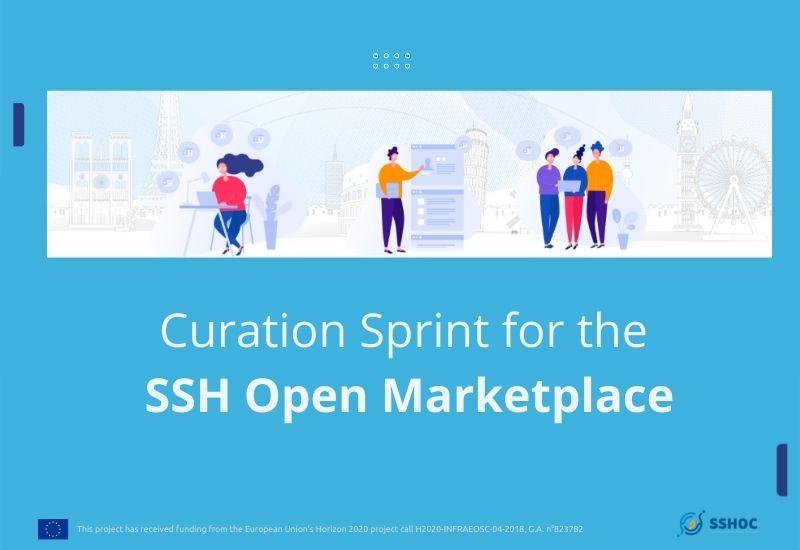
- Social Sciences & Humanities Open Cloud
Curation Sprint for the SSH Open Marketplace

Date:
24 November 2021
It’s all about curation
How the community can contribute to the SSH Open Marketplace
In previous posts we explained the concept of the SSH Open Marketplace. As a reminder: Much of the content of the Marketplace is harvested from third party sources, such as Programming Historian or the CLARIN Switchboard tool inventory, but researchers can also curate or even add new resources relevant to their daily research work.
Population phases of the SSH Open Marketplace
Three subsequent phases describe our work for populating the Marketplace with content:
- Initial onboarding phase: Between the start of the project and the Alpha release in June 2020, we primarily implemented well-known content collections.
- Extended population phase: Community feedback received during the Alpha release informed our efforts to add further content to the Marketplace and to refine the presentation of the individual record. As the aim is not only to have much content present but also to connect the elements to provide context, the ingestion of new sources will need to include associated background information on digital research methods and approaches.
- Community supported phase: Once the Marketplace has reached a certain maturity and uptake by the users, we intend to involve the community substantially in the curation and enhancement of the content. We started this phase with an internal curation sprint on October 14th 2021 aimed at our colleagues within the SSHOC project.
What is community curation?
Community curation might be as simple as a suggested correction or a comment to an individual item, but could also take more advanced shapes. One pillar of a successful platform is the availability of powerful curation workflows and tools that help to improve the quality of the data, thus enriching the content and helping users gain new perspectives. In this regard, the development of curation tools - please keep the curation dashboard in mind for later! - is a major focus of this phase. Offering a wide selection of useful material is key to attracting an open and active community. We believe our curated, context-driven approach will help researchers gain new ideas, useful documents, exciting tools to try out, and recommendations by peers from different research communities, institutions, and countries. We envision a lively community boosting the SSH Open Marketplace not only for the benefit of the SSH domain but also as an integral part of the larger European Open Science Cloud where it will align with many other disciplines.
A few words on the ownership of content in the SSH Open Marketplace
If you browse the Marketplace, you will recognise that the provenance of many records is related to certain third party sources. Let’s take the CLARIN Switchboard tool inventory as an example. These sources are usually maintained by owners or a dedicated community, which we see as natural partners of the Marketplace.
For instance, CLARIN achieves a wider visibility for its services and resources through exposure in the Marketplace. This can be enhanced even more by relating the content of the tool inventory (to stay within our example) to other content, which either may not be owned by CLARIN or may not entirely match the collection scope of the Switchboard but could be useful for researchers from other research or data domains. To ensure a good relation with the “content owners”, we address them as stakeholders of the Marketplace and want to encourage them to contribute to the quality of “their content” in the Marketplace. This applies to stakeholder groups like CLARIN or DARIAH but also to individual researchers. Curation, be it a once-only occasion or a more frequent involvement as a moderator, is open for everyone.
How does a curation sprint work and how can you partake?
Taking the remarks on ownership of content in mind, you can imagine that a curation sprint is a suitable instrument to focus on a set of records in the Marketplace and to curate it in a joint effort of SSHOC people and content stakeholders. Ideally, a curation sprint creates a sense of ownership for certain sets of content and contributes to its future maintenance, enrichment and contextualisation.
The 1st Curation Sprint was conducted on October 14th as a two hour-long Zoom call, the group consisting of 19 people, most of them being part of the SSHOC team but also beyond. We focussed on three topics:
- Testing and evaluation of the curation dashboard, including accessibility (EOSC AAI) and usefulness of the editing workflow.
- Curating a small set of records coming from the CLARIN Switchboard.
- Curating of a set of records on training material coming from the Standardization Survival Kit.
As this was the first sprint, the discussion revolved around testing and evaluating the Marketplace as such and particularly the curation dashboard. We received valuable feedback from the participants which, in turn, influenced the curation workflow and technicalities of editing content in the Marketplace. Our aim is to provide an as-easy-as-possible solution for the curation and therefore, based on the feedback we received, we are working towards aligning the system architecture to a more user friendly curation process.
Have we sparked your interest in the SSH Open Marketplace? Please keep an eye for upcoming curation activities of SSHOC and consider taking part in it. In the end, it is the lively interaction among individuals which characterises “the community” and we try to live up to this principle.
